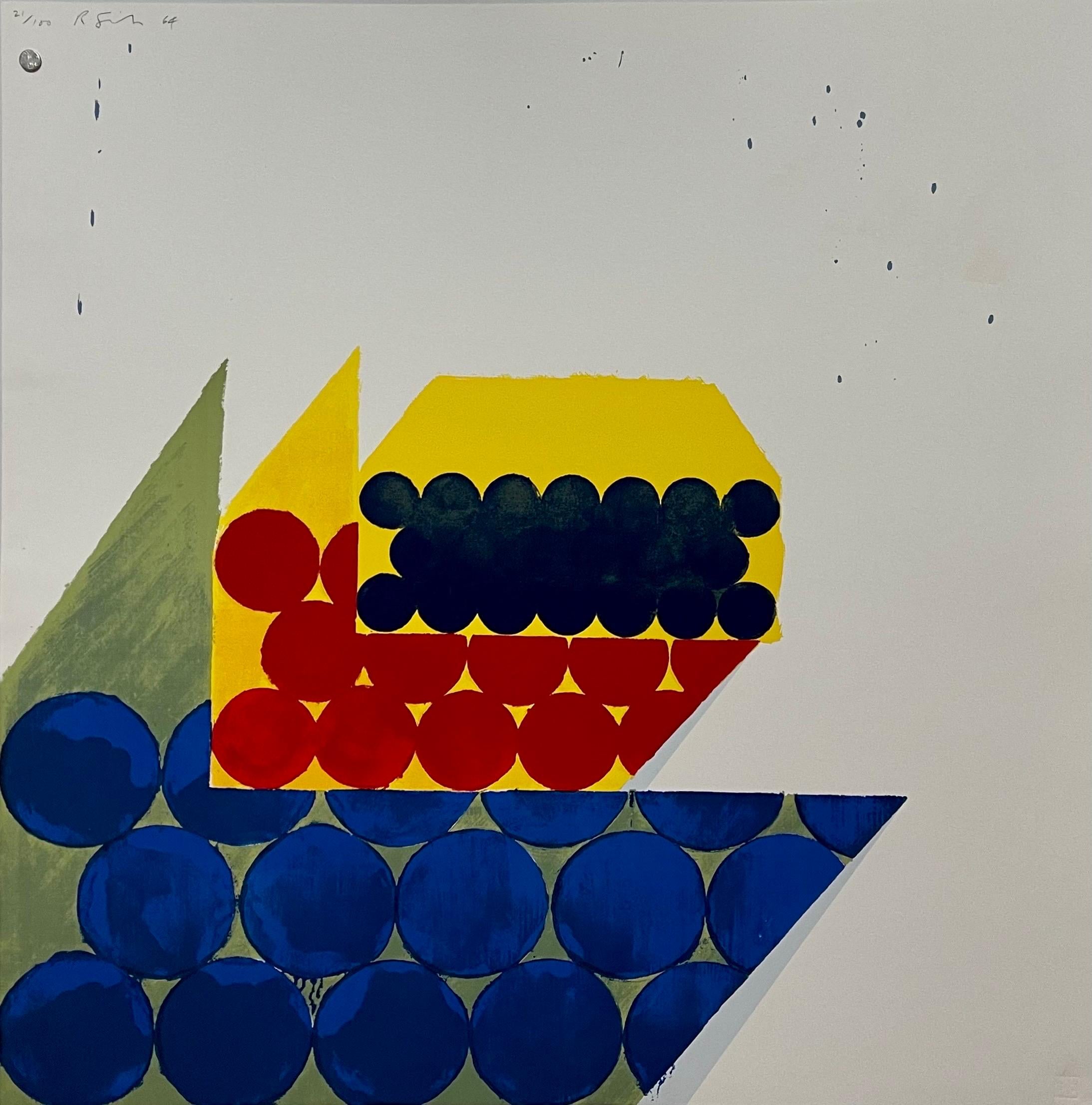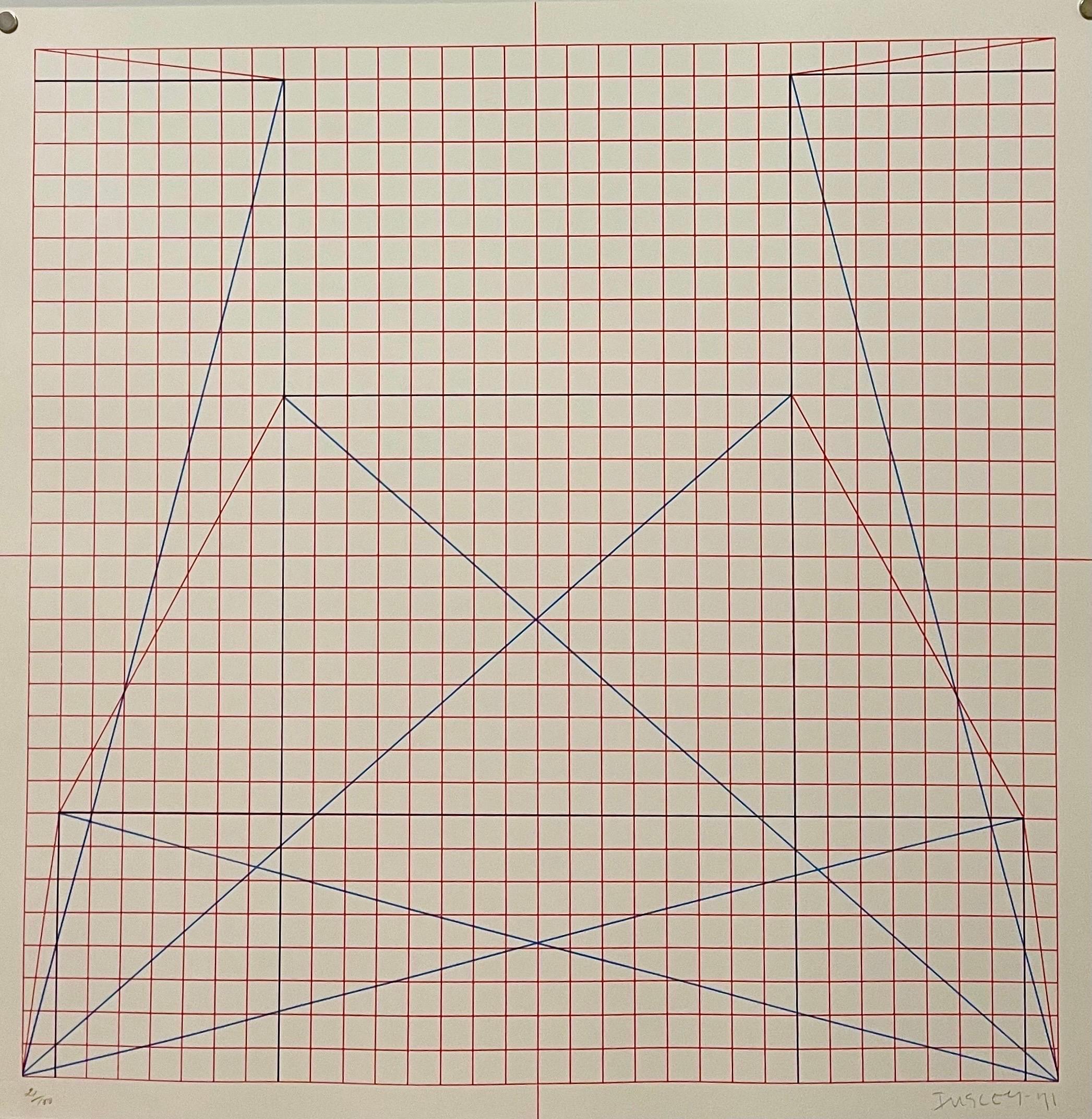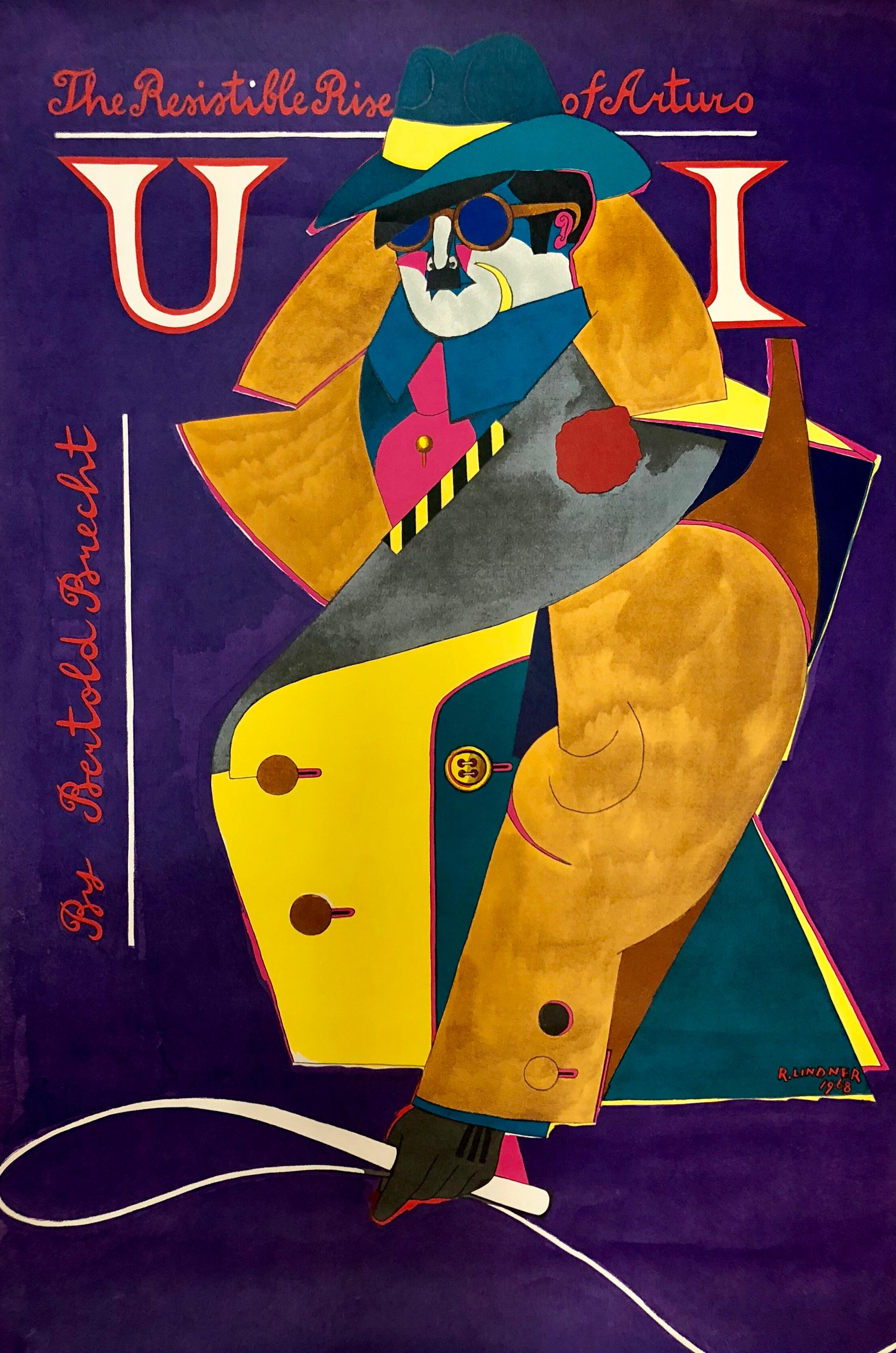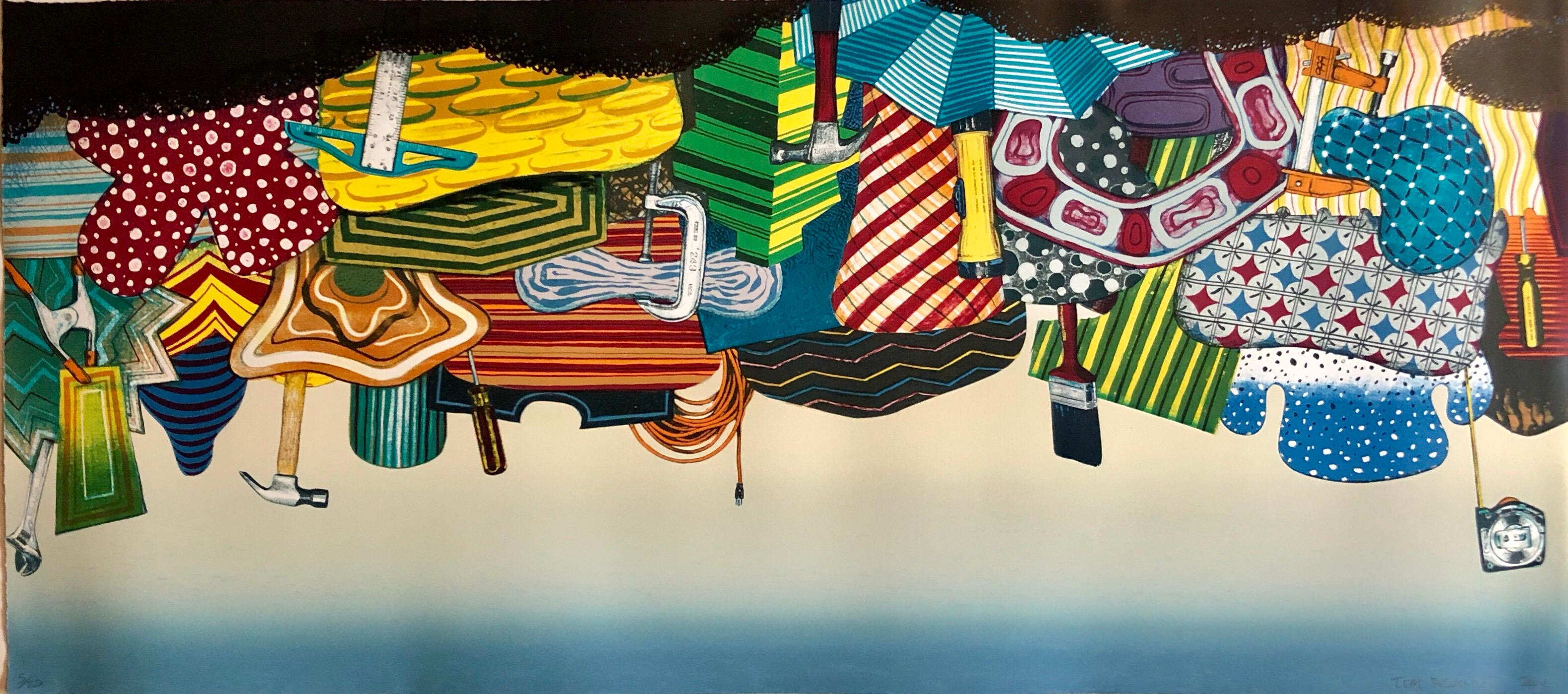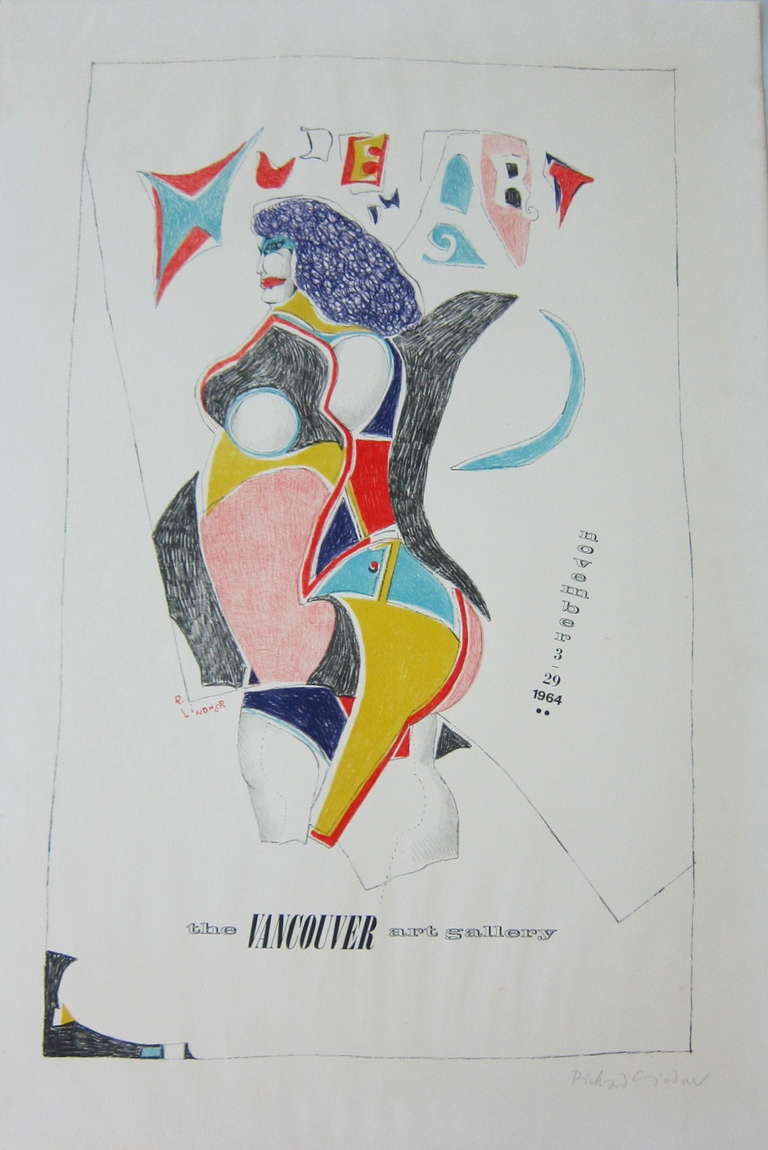James RosenquistIce Point1983
1983
About the Item
- Creator:James Rosenquist (1933, American)
- Creation Year:1983
- Dimensions:Height: 33.47 in (85 cm)Width: 24.02 in (61 cm)
- Medium:
- Movement & Style:
- Period:
- Condition:
- Gallery Location:Ljubljana, SI
- Reference Number:
James Rosenquist
Although he insisted that he and his fellow Pop artists developed their art-making styles independently, American painter James Rosenquist belonged at the table with Andy Warhol and Roy Lichtenstein.
Known for his distinctive use of visual montage, Rosenquist produced large, vibrantly colored tableaux marked by fragmentation and overlap. He often employed familiar motifs and objects drawn from popular contemporary culture — hot dogs, lipstick tubes, American flags — which he manipulated to form disorienting compositions whose constituent elements are nearly unrecognizable.
Born in North Dakota to Swedish parents, Rosenquist was encouraged to pursue painting by his mother, who was also an artist. He studied painting for two years at the University of Minnesota, but dropped out at the age of 21 to attend the Art Students League in New York on a scholarship. A job as a billboard painter in the late 1950s set him up to pursue his signature style, which borrowed its bold graphics and remixed kitschy aesthetic from the visual vocabulary of advertising. Works like Flamingo Capsule (1983) embody his trademark visual dissonance, drawing cigarette-ad motifs into conversation with stripes from the American flag and aluminum foil wrappers.
In addition to enormous paintings, Rosenquist created drawings, prints and collages. The 2011 lithograph The Memory Continues but the Clock Disappears is a montage of melting clocks and confetti, all submerged in a pool of water. While wryly hinting at the inevitability of decay and deterioration — suggesting that life is a ticking clock — the composition also alludes to Salvador Dalí's signature motif, the defining symbol of Surrealism. Such compositions demonstrate how Rosenquist masterfully combined seemingly incongruous elements into a harmonious and poetic whole.
Find James Rosenquist art today on 1stDibs.
- ShippingRetrieving quote...Ships From: Ljubljana, Slovenia
- Return PolicyA return for this item may be initiated within 7 days of delivery.
- BallsBy James RosenquistLocated in Ljubljana, SIBalls 1990. Original color silkscreen, 1990. Edition of 130 signed and numbered impressions on Arches paper. James Rosenquist is one of the biggest American artist of second part of ...Category
1990s Pop Art Abstract Prints
MaterialsScreen
- Ski TracksBy Piero DorazioLocated in Ljubljana, SIOriginal color lithograph, 1983. Edition of 150 signed and numbered impressions on Arches paper. Art and Sport portfolio: The Yugoslav Olympic Committee of the Winter Olympic Games S...Category
1980s Abstract Abstract Prints
MaterialsLithograph
- The Songs of the Blacks and the BluesBy Louise BourgeoisLocated in Ljubljana, SIThe Songs of the Blacks and the Blues. Original color lithograph, woodcut, gouache and oil-stick editions, 1996. Edition of 40 signed and numbered impressions on Arches paper. Louise...Category
1990s Post-Modern Abstract Prints
MaterialsMixed Media, Gouache, Lithograph, Woodcut
- OlympiaBy Friedensreich HundertwasserLocated in Ljubljana, SIOriginal signed color poster lithograph, 1983. Edition of 150 signed and numbered impressions on Arches paper. Art and Sport portfolio: The Yugoslav Olympic Committee of the Winter O...Category
1980s Post-Modern Abstract Prints
MaterialsLithograph
- StarsLocated in Ljubljana, SIStars. Original color lithograph, 1975. Edition of 16 signed and numberes impressions on Arches paper. Metka Krašovec is one of the most important painters in contemporary Slovenian ...Category
1970s Post-Modern Abstract Prints
MaterialsLithograph
- Horse Ride-Green, Violet, BrownBy Joan MiróLocated in Ljubljana, SIHorse Ride-Green, Violet, Brown. Original color lithograph, 1969. Edition of 75 signed and numbered impressions on Arches paper. Joan Miró was a famous Spanish Catalan surreal painter, sculptor and ceramicist, but he also created graphics, large installations and murals. His radical style for that time was a contribution to the early-20th-century avant-garde and complete abstraction later. Early fauvistic works showed the influence of Cézanne, in cubist compositions, but also a reference to the avant-garde interests of the painter. Few years later he started to change his artistic approach over the magic realism to surrealism. His surfaces become abstract and stayed like that until the rest of his career. Miró’s mature style evolved from the tension between his fanciful, poetic impulse and his vision of the harshness of modern life. The artworks are reflections of his subconscious mind, filled with pictorial signs, biomorphic forms, geometric shapes, and abstract and semi-abstract objects. He worked extensively in lithography and produced numerous murals, tapestries, and sculptures for public spaces. Miro’s composition...Category
1960s Abstract Expressionist Abstract Prints
MaterialsLithograph
- Abstract Minimalist Color Silkscreen Print Richard Smith On The Bowery Pop ArtBy Richard SmithLocated in Surfside, FLRichard Smith On the Bowery, 1969 - 1971 silkscreen on Schoeller's Parole Paper, edition of 100 + 20 A.P. 25.5 x 25.5 inches, signed, numbered 21/100 Screenprint in color on wove paper Hand signed, published by Edition Domberger, Bonlanden, West Germany (with their blindstamp) Provenance: Collection of Tom Levine On the Bowery, 1971. The portfolio consists of nine screenprints in colors (one with mylar collage), on wove paper, by representative artists of the Pop Art period. Cy Twombly, Robert Ryman, Will Insley, Robert Indiana, Les Levine, John Willenbecher...Category
1960s Pop Art Abstract Prints
MaterialsLithograph, Screen
- Color Silkscreen Pop Art Lithograph Print Les Levine Canadian Pop Art PortraitBy Les LevineLocated in Surfside, FLLes Levine On the Bowery, 1969 - 1971 Screenprint in color 25.5 x 25.5 inches, signed, numbered 21/100 Hand signed, published by Edition Domberger, Bonlanden, West Germany (with their blindstamp) Provenance: Collection of Tom Levine On the Bowery, 1971. The portfolio consists of nine screenprints in colors (one with mylar collage), on wove paper, by representative artists of the Pop Art period. Cy Twombly, Robert Ryman, Will Insley, Robert Indiana, Les Levine, John Willenbecher...Category
1960s Pop Art Abstract Prints
MaterialsLithograph, Screen
- Abstract Minimalist Color Silkscreen Print Will Insley On The Bowery Pop ArtLocated in Surfside, FLWill Insley On the Bowery, 1969 - 1971 silkscreen on Schoeller's Parole Paper, edition of 100 + 20 A.P. 25.5 x 25.5 inches, signed, numbered 21/100 Screenprint in color on wove paper Hand signed, published by Edition Domberger, Bonlanden, West Germany (with their blindstamp) Provenance: Collection of Tom Levine On the Bowery, 1971. The portfolio consists of nine screenprints in colors (one with mylar collage), on wove paper, by representative artists of the Pop Art period. Cy Twombly, Robert Ryman, Will Insley, Robert Indiana, Les Levine, John Willenbecher...Category
1960s Pop Art Abstract Prints
MaterialsLithograph, Screen
- Offset Lithograph Poster Resistible Rise of Arturo, Bertold Brecht 1968 Pop ArtBy Richard LindnerLocated in Surfside, FLPlate signed and dated, offset lithograph. Richard Lindner was born in Hamburg, Germany. In 1905 the family moved to Nuremberg, where Lindners mother was owner of a custom-fitting co...Category
1960s Pop Art Abstract Prints
MaterialsLithograph, Offset
- Color Lithograph Linocut Chine Collé "Workshop" Bright Modernist Pop ArtBy Tom BurckhardtLocated in Surfside, FLHand signed and numbered edition of 25. 16 x 36" sheet size without frame. “Workshop” is an ambitious color lithograph and linocut with chine collé printed in twelve colors from nine plates and one linocut. It has been printed in an edition of 25, plus proofs, on white Rives BFK paper 16 x 36” with chine collé of various papers. (No, it’s not upside down) Born 1964 in New York where he still currently resides and works alongside his partner the ceramist Kathy Butterly. Son of the photographer Rudy Burckhardt and painter Yvonne Jacquette, Tom Burckhardt was 1986, BFA, State University of New York, Purchase, NY 1992–1993, Skowhegan School of Painting and Sculpture, ME 1996, Marie Walsh Sharpe Art Foundation Studio Grant 1997, New York Foundation for the Arts, Painting Grant 1997 Pollock-Krasner Foundation Grant 2002 George Hitchcock Award, National Academy of Arts 2003, Richard & Hinda Rosenthal Foundation Award, American Academy 2005, AICA Best Show of an Emerging or Underknown Artist 2005 Pollock-Krasner Foundation Grant 2006 Best Installation, Best of Houston, the Houston Press 2009 Guggenheim Foundation Grant 2010, New York Foundation for the Arts Drawing/Print Grant 2010 Joan Mitchell Foundation Grant Tom Burckhardt’s work is a carnival of images jumbled and jostling each other in precarious nonsensical compositions. He uses lushly colored and patterned images from all kinds of sources that bounce between abstraction and representation. Images come from tool catalogs, paper and fabric patterns, funhouse painting, architectural details, stripes, dots and squiggles. It is as if Burckhardt is a cartoonist merrily channeling Ellsworth Kelly, Paul Feeley, Robert Therrien, and Myron Stout, among others. Like Red Grooms, for whom he worked as an assistant, Burckhardt ransacks his influences yet ends up with something unmistakably his own. His work bears the influence of is a synthesis of many things: the tribal-influenced abstract painting of Steve Wheeler...Category
Early 2000s Pop Art Interior Prints
MaterialsLinocut, Lithograph
- Vintage Modern Lithograph Poster 1960s Pop Art Mod Figure Pencil SignedBy Richard LindnerLocated in Surfside, FLRichard Lindner was born in Hamburg, Germany. In 1905 the family moved to Nuremberg, where Lindners mother was owner of a custom-fitting corset business and Richard Lindner grew up and studied at the Kunstgewerbeschule (Arts and Crafts School since 1940 Academy of Fine Arts). From 1924 to 1927 he lived in Munich and studied there from 1925 at the Kunstakademie. In 1927 he moved to Berlin and stayed there until 1928, when he returned to Munich to become art director of a publishing firm. He remained there until 1933, when he was forced to flee to Paris, where he became politically engaged, sought contact with French artists and earned his living as a commercial artist. He was interned when the war broke out in 1939 and later served in the French Army. In 1941 he went to the United States and worked in New York City as an illustrator of books and magazines (Vogue, Fortune and Harper's Bazaar). He began painting seriously in 1952, holding his first one-man exhibit in 1954. His style blends a mechanistic cubism with personal images and haunting symbolism. LIndner maintained contact with the emigre community including New York artists and German emigrants (Albert Einstein, Marlene Dietrich, Saul Steinberg). Though he became a United States citizen in 1948, Lindner considered himself a New Yorker, but not a true American. However, over the course of time, his continental circus women became New York City streetwalkers. New York police uniforms replaced European military uniforms as symbols of authority.At a time when Abstract Expressionism was all the rage, Lindner’s painting went against the current and always kept its distance. His pictorial language of vibrant colours and broad planes of colour and his urban themes make him a forerunner of American Pop Art. At the same time, he owes the critical tone of his paintings to the influence of European art movements such as Neue Sachlichkeit and Dada. His first exhibition did not take place until 1954, by which time he was over fifty, and, interestingly, it was held at the Betty Parsons Gallery in New York, a venue associated with the American Expressionists. From 1952 he taught at the Pratt Institute, Brooklyn, from 1967 at Yale University School of Art and Architecture, New Haven. In 1957 Lindner got the William and Norma Copley Foundation-Award. In 1965 he became Guest Professor at the Akademie für Bildende Künste, Hamburg. His Ice (1966, Whitney Museum of American Art) established a connection between the metaphysical tradition and pop art. The painting shows harsh, flat geometric shapes framing an erotic but mechanical robot-woman.His paintings used the sexual symbolism of advertising and investigated definitions of gender roles in the media. While influencing Pop Art (Tom Wesselman and Claes Oldenburg amongst others) his highly colourful, hard-edge style seems to have brought him close to Pop Art, which he rejected. Nevertheless, he is immortalised on the cover of the Beatles record...Category
1960s Pop Art Abstract Prints
MaterialsLithograph
